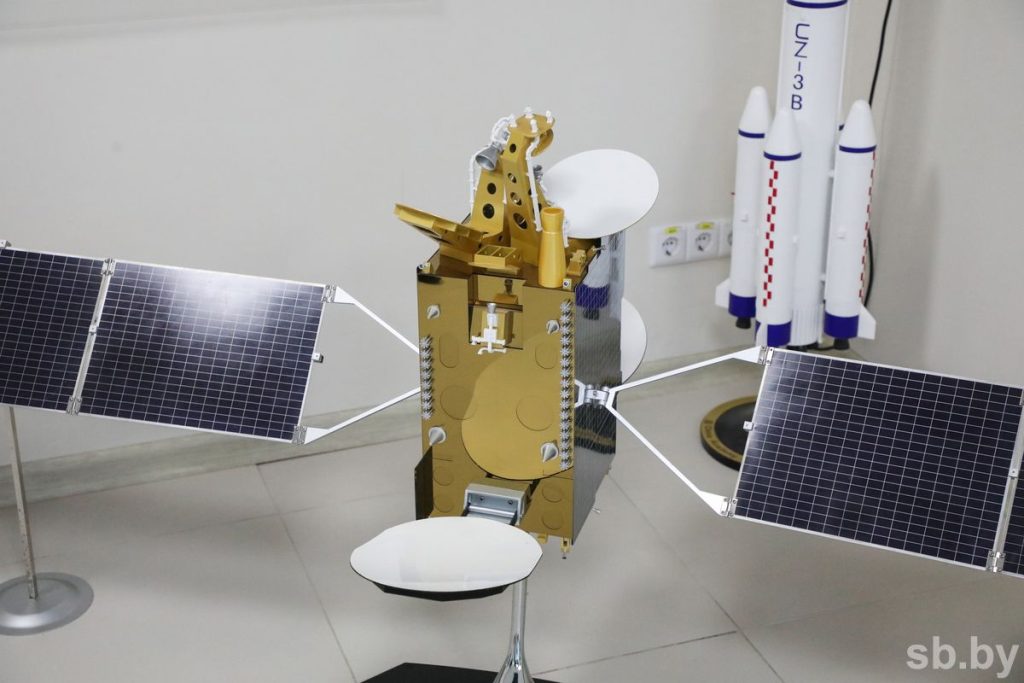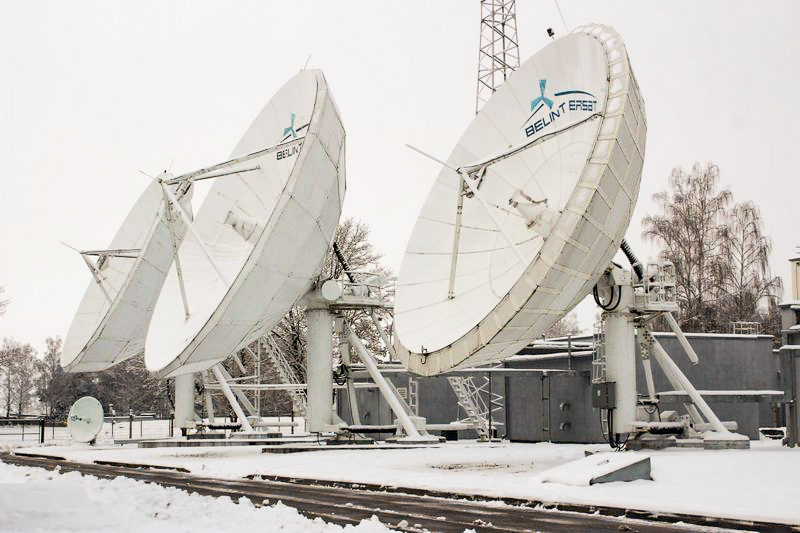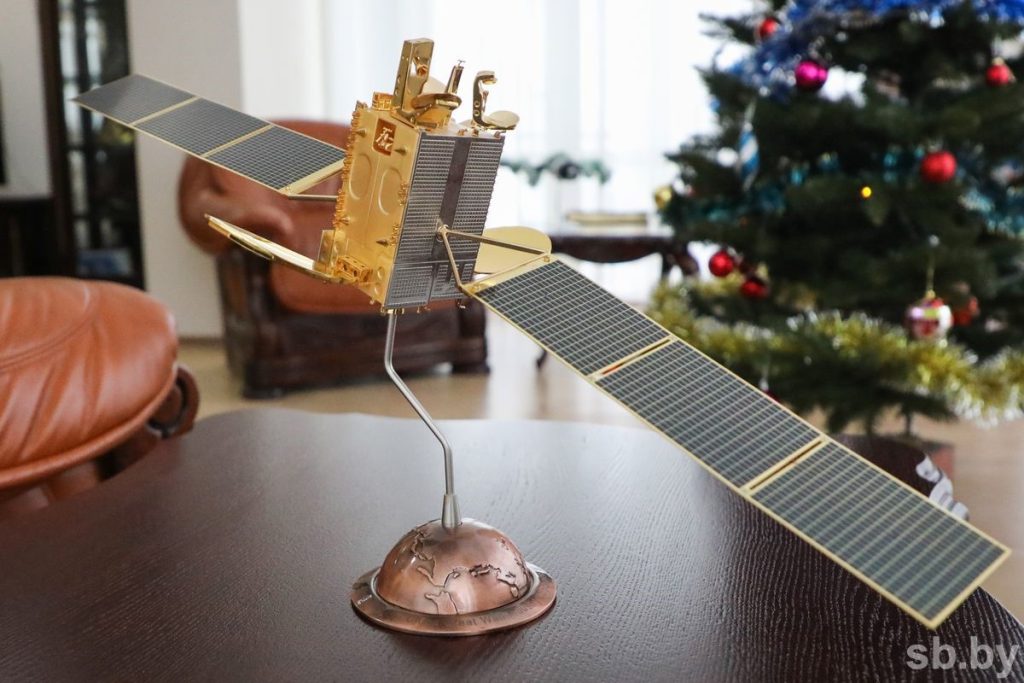Our space capabilities
The creation of the National Satellite Communications and Broadcasting System of Belarus has become an important stage in improving telecommunications necessary for the innovative development of the country. The decision to create it was made by the President of Belarus Alexander Lukashenko in 2011. 15 January marked eight years since the first Belarusian satellite Belintersat-1 was launched into geostationary earth orbit. It became a key element of the National Satellite Communications and Broadcasting System and allowed our country to enter the global satellite services market. Together with the Belintersat team, we looked at how the satellite operates in orbit using a ground-based control complex, and found out the possibility of continuing the existing project.

Competition between technologies and prices
The satellite control complex is located in the village of Stankovo, Dzerzhinsky district. The ground infrastructure consists of six huge antennas that transmit and receive signals. Employees are on duty here around the clock. Large screens display all the information about the satellite’s well-being. Specialists display detailed data on computer monitors. This is how employees monitor specific vital signs of the satellite.
Today, the Belintersat project team provides a full range of popular satellite communication services in Belarus and abroad – in Europe, Africa and Asia. The head of the ground control complex, Oleg Vinyarsky, says that over eight years of work in the country, the operator managed to create a separate niche in communication services from scratch:

— After the decision was made at the state level to create a National Satellite Communications and Broadcasting System, an alternative to terrestrial communication channels appeared in the country. Until this point, the alternative was mainly radio communication, but it has a short range. Now the satellite coverage area is 100 percent of the territory of Belarus. This has played a significant role in improving the quality of provision of new services to users.
When the conversation turns to satellite communications, many immediately recall Elon Musk’s acclaimed Starlink satellite project. It functions well in low orbits, while Belintersat-1 is positioned in a higher, geostationary orbit. The head of the satellite ground application center, Andrei Yanovich, explained why our country took this particular path:
— The advantages of a geostationary satellite over a low-orbit one are that it stands motionless relative to the Earth. For the user, this means that he set up the antenna once and forgot – there is always a connection. It’s more difficult with low-orbit ones. You need to monitor them by constantly rotating the antenna or use an expensive solution using special antenna arrays. In this case, there will be no communication when the satellite is on the far side of the Earth. You can follow the path of Elon Musk and launch many satellites, but this requires complex technical solutions and is very expensive. Most countries, including us, have chosen the geostationary route.

About 300 TV and radio channels
We enter the mission control center. There is a shift of five people on duty, three of whom directly control the spacecraft. They monitor the status of the satellite’s payload and monitor signal quality.
Fixing a satellite at one point is not an easy task. He literally strives to go astray. This happens because the Earth is not perfectly round. This is also influenced by various cosmic factors. Therefore, the team constantly monitors navigation parameters and adjusts them, explains Pavel Starovoitov, head of the satellite’s flight control center:
— Modern tools allow us to predict the satellite’s flight path up to 14 days in advance and tell in advance with a high degree of confidence when the operator needs to intervene and make adjustments. Why is this necessary? If the vehicle leaves its orbital position, it will affect customers on Earth, those who use our services. They will receive poor quality service or no service at all. Other space operators will also suffer – their devices will begin to transmit signals with interference. As you can see, we have a very big responsibility.
On the territory of Belarus, Belintersat provides satellite communication services and solutions for cellular operators for commercial and government structures, organizes corporate data networks and carries out live radio and TV broadcasts.
But the main industry market of the project is the television and radio broadcasting market. Today, Belintersat-1 distributes content from about 300 TV channels and radio stations in Central and Western Europe and Africa. In the African region alone, the Belarusian communications satellite has more than 15 million users. The most important thing is that it made it possible to broadcast a high-definition television package to the public in Belarus.
Six huge antennas transmit and receive signals.
Commercial prospects
The implementation of the project made it possible to strengthen the country’s position in the global information community, ensure its information independence, as well as introduce new technologies and increase the country’s export potential. In general, the project is export-oriented and designed to maximize the sale of satellite resources to government and corporate clients and operators in countries near and far abroad.
To meet the needs of Belarusians, 5 percent of the satellite’s resource is enough, and they are used by services that must respond as quickly as possible to man-made, abnormal, emergency situations, and ensure border protection and public order. The remaining 95 percent can be exported.

And the team’s task is to conquer reliable and promising niches in the national and foreign markets. This has to be done in conditions of fierce competition between operators: more than 300 satellites are operated in geostationary Earth orbit.
Nevertheless, Belintersat’s portfolio of services is constantly being updated with new innovative and reliable communication solutions, says Alexey Kontarev, head of the satellite communications sector of the commercial department:
— We have ten direct competitors, similar in payload and coverage area. There is also competition from high-throughput HTS satellites. Low-orbit vehicles are actively entering the market… In addition, trends in the space industry are changing very quickly. Consumers are less willing to enter into long-term contracts. For three to five years maximum. With some we sign agreements only for a year.
As an example, Alexey Kontarev cited the African market, where Belintersat is actively working. It is very unstable due to the political situation in the region, and long-term planning in this market is not practical at this stage.
Despite all the difficulties caused by the oversaturation of the market with offers, the project team managed not only to prevent a decline, but even to significantly increase the share of commercial use of the payload of the Belintersat-1 satellite. Today this indicator is comparable to the indicators of the world leaders in the industry.
The communications satellite also contributes to strengthening the defense capability and security of Belarus, Alexey Kontarev emphasizes:
— Communication and telecommunications technologies are economically profitable projects. Therefore, this project really allows the Belarusian economy to receive new investments. In the domestic market, government agencies became our growth point.
In recent years, attention to defense capability, national security of the state, and response to emergency situations has seriously increased. This, by the way, is a global trend. Belarusian government departments and organizations (for example, border guards, rescuers and a number of other structures) also understand the need for satellite communications and want to have separate channels for themselves.

Growth points
The operational life of the Belintersat-1 satellite is 15 years from the moment of launch. It will exhaust its resource in seven years. However, thanks to competent satellite management, which largely manifests itself in avoiding unnecessary maneuvers in orbit, we are able to significantly save fuel and, therefore, extend the life of the satellite by more than a year and a half.

It would seem that there is still a lot of time ahead. However, experts are looking to the future and are already working on justifying the need to launch a second device. The fact is that the creation of a telecommunications geostationary satellite is a slow process, explains Oleg Vinyarsky:
— We are talking about the continuation of the existing project. It will take about three years to design and manufacture Belintersat-2. But conditions must be met that relate to an established logistics chain between manufacturers and the assembly center. In addition, we must not forget that other countries are pursuing strict sanctions policies against Belarus. Before we begin assembling the second satellite, we need to conduct a thorough market research and determine the needs of consumers of satellite services.
That is, the developers have 5-7 years to work out all the nuances, create a preliminary design of the appearance of the new satellite, carry out all stages of platform and payload design, and most importantly, manufacture the satellite, test it and launch it successfully.
“It must be a satellite with high throughput, which will significantly exceed the current one. Work on the appearance of a satellite with improved characteristics will require specialists to resolve issues related to the modernization of ground infrastructure, and this should be significant. Such decisions are very serious and expensive,” added Oleg Vinyarsky. – But there is no way to do without this. There is a future in high throughput.
The launch of a second communications satellite would expand the range of services provided. For example, the Belintersat project now has a license to provide fixed-line communication services. In the future, it would be possible to provide a mobile type of communication that is relevant in modern realities. Already at this stage it is necessary to foresee how the new type of service will fit into the existing architecture of the internal communications market and how it will complement it. Time will tell how popular they will be. But it is already obvious that the Belintersat project has high innovative, economic and social significance.
Text: Inna Gorbatenko
Photo: Alexey Vyazmitinov
Source: newspaper “REPUBLIC” (sb.by)









